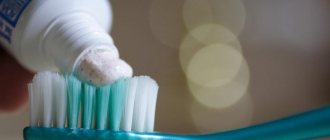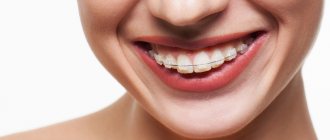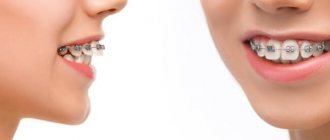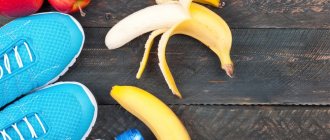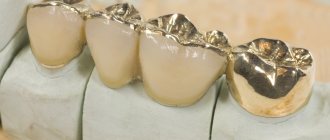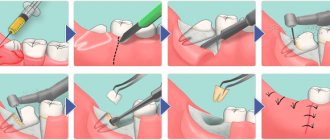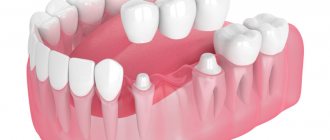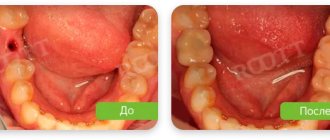The turn- key braces system effectively corrects the bite and straightens the dentition in adult patients of different ages. Certain contraindications to wearing fixed orthodontic structures, of course, exist. But in the vast majority of cases, mature people who decide to create an attractive open smile manage to achieve the planned result. You just need to prepare in advance for long-term treatment, during which you will have to adhere to strict discipline and strictly follow all the instructions of the attending physician. In this case, patients will be pleasantly surprised by the result.
What can you eat in the first days after getting braces?
Almost immediately after fixing the brace system in the oral cavity, the patient will experience unpleasant sensations associated with increased pressure on the dentition. Chewing may cause severe pain. Therefore, experts recommend in the first days to give preference to soft and strained food. The following products and dishes are optimal:
- liquid porridge;
- soups;
- cottage cheese;
- kefir;
- yoghurts;
- jelly;
- vegetable puree, etc.
Teeth hurt from braces: 3 main reasons:
There are three main reasons why orthodontic devices cause jaw pain. This is the effect of the arc on units and rubbing of the oral mucosa by the elements of the system.
- Arc pressure.
Braces systems move teeth using the main element – a power arc. This is a thin metal wire with shape memory that puts pressure on the tooth and moves it to the physiologically correct place.
The remaining details - clasps, ligatures, rings - are auxiliary. Their main function is to fix and hold the power wire.
It is the movement of the roots that causes the most intense pain sensations. The teeth literally make their way into the bone and soft structures. The process is accompanied by resorption (rarefaction) of tissues on the one hand and their compaction on the other. That's why pain occurs.
- Irritation of the oral mucosa after installation of braces
The main part in braces that injures the mucous membrane is the clasps. These are special staples. They are attached to the enamel and equipped with grooves in which the arc is fixed.
The elements protrude by several millimeters, and their edges, no matter how hard the manufacturers try, cannot be perfectly smooth. Therefore, the tongue, inner lips and cheeks often chafe.
The sensations are pronounced, but the “brace wearer” quickly learns to handle the parts carefully, and the mucous membrane becomes a little keratinized (thickened) over time. And the discomfort goes away.
- Excessive pressure.
If the orthodontist has tightened the wire too tightly, the units will experience increased stress.
- Injury from the edges of the arc.
It is usually folded behind the last molars. But if this is not done, the wire is too long or has come out of the groove, it will scratch the cheeks. The same thing happens when the device breaks down. Breaking the ligature and peeling off the staples violate the integrity of the structure, and its parts begin to tear apart the oral cavity.
Pain and discomfort when installing braces:
Severe pain does not occur during fixation of the structure. The procedure lasts 2 – 3 hours. During this procedure, the orthodontist positions the clasps on the enamel with a special adhesive (bond), fixes the wire and activates the device. All a person will feel is a small onslaught.
Discomfort may be associated with:
- staying in one position for a long time with your mouth open - this causes the muscles of the face, neck and back to become numb;
- installed mouth dilator - it is needed to get a good view and trouble-free access, but it can rub the corners of the lips and lead to their drying out;
- activation of braces - immediately after it the bite begins to align, pressure arises.
The sensations are not very pronounced, you just have to endure them. The only thing that can be done is to lubricate the lips and the area around them with a rich cream and hygienic lipstick before the manipulation. This will prevent the patient from excessive drying of the skin and the appearance of cracks on it.
The most difficult period is the first week, how to relieve pain?
The most intense pain is typical after installing a brace system and when changing the archwire. This is a normal condition that will go away by the end of the week. in the first days, eat only semi-liquid food at room temperature - juices, yoghurts, jelly, baby purees;
- take an anesthetic or non-steroidal anti-inflammatory drug - Ibuprofen, Nise, Ketonal, Paracetamol;
- use local anesterizing drugs with lidocaine - “Cholisal gel”, “Dentinox”, “Kamistad”;
- eat ice cream or drink cool water - the cold will reduce the intensity of sensations;
- if the wire damages the cheek, you must ask the dentist to cut it and bend it;
- when discomfort is caused by excess pressure, you need to consult a doctor to relieve it;
- If it breaks down, visit the orthodontist - he will replace the parts and adjust the system.
If the pain is too intense, radiating to the head and neck, you should urgently visit the clinic. The specialist will identify and eliminate the cause.
The last stage of wearing braces is painless!
At the end of the bite correction, nothing should hurt. The new smile is almost ready, and the last months of wearing it are needed so that the bone structures have time to finally form. Removing braces is absolutely painless. The only thing that may occur is hyperesthesia - excessive sensitivity of the enamel. It develops due to microcracks that appear when wearing the device.
To relieve hyperesthesia, remineralization and fluoridation are performed.
What food is preferred throughout treatment?
When the patient gets used to the brace system, you can gradually expand the diet. The following is a list of products that will not cause any harm to the orthodontic structure:
- soups;
- yoghurts, kefir;
- soft cheeses;
- soft chicken fillet, thin sliced meat;
- fish, crab sticks;
- eggs;
- pasta;
- boiled rice;
- mashed potatoes;
- soft pastries, pancakes, bread crumbs;
- applesauce;
- bananas;
- jelly;
- milkshakes;
- vegetable caviar, stewed vegetables;
- cutlets, pureed meat.
The list of recommended products is quite large. It is important to understand that you should not bite hard food with your teeth. But if, for example, you grate an apple or carrot, you can eat them without fear for the safety of your braces.
Good to know. Braces are the best “nutritionist”. By adhering to some dietary restrictions, patients will receive not only straight and beautiful teeth, but also a slender figure.
Can braces come off?
The system is securely, but not tightly, attached to a special glue, and when biting on some products, its elements may come off. This most often occurs when eating solid foods. If one or more braces come off, you need to consult a doctor.
You can install braces at the Saint-Dent Clinic in Moscow. Qualified dentists of all specializations work here. The clinic uses advanced technologies and modern materials to treat patients. The contact page is located here Contacts. Patients can find out the cost of dental services here Prices for dental services.
When and how are braces removed?
The doctor decides when to remove braces. It depends on the:
- state of the dentition - a small degree of defect (one or two crooked teeth) is restored faster than complex malocclusions;
- the age of the patient - correction is most quickly carried out in adolescence; in adults this is a longer process;
- type of braces - the fastest correction process occurs when using Damon System braces.
On average, for a complete correction of the dentition, an adult will need to wear braces for 2 to 3 years. In adolescence, this period can be reduced to a year or even several months. Only an orthodontist removes braces; removing the system yourself is prohibited.
The procedure for removing braces is painless. Stages:
- application of a special retractor-mouth dilator;
- removal of ligatures and arches with tweezers;
- removing locks from each tooth one by one;
- cleaning crowns from dental glue-cement using a special attachment for a drill;
- application of paste with fluoride and calcium to the crowns of teeth to strengthen the enamel.
The doctor can remove braces from only 1 jaw, or from both at the same time.
What to do after removal
After the braces are removed, the teeth may partially return to their original position after some time. This is especially common in adults. To prevent this from happening, special devices are prescribed to hold the teeth in the correct position:
- non-removable devices – retainers; are metal arches fixed to the inner surface of the teeth; they are invisible to others, do not cause discomfort and the patient quickly gets used to them;
- removable devices - mouthguards; These are transparent plastic caps that can be removed and put on independently; You need to wear it at least 18 hours a day.
The doctor decides how long you need to wear retainers or mouth guards. Sometimes it takes twice as long as wearing braces.
Very often, patients are interested in questions about whether it is possible to whiten their teeth immediately after removing braces. Most dentists believe that it is better to carry out such a procedure no earlier than after 4 months, since the enamel must strengthen after prolonged injury. But everything is individual, and if the defects were small, the time of wearing braces was several months, the orthodontist may allow whitening to be carried out even after a month.
When a patient has been missing one or more teeth for a long time, this leads to bone tissue atrophy and a decrease in the bone cell of the tooth. If the patient wants to have a dental implant, he will first need to expand the bone cell using braces. After removing the braces, implants can be installed immediately, since the implanted titanium root will hold the teeth in the correct position.
Find out more about modern dental implant methods in our blog.
Hard and sticky food
Eating solid foods leads to damage to the arch structure and displacement of the dentition. This also often causes locks to come unstuck. The following products are completely prohibited:
- nuts;
- crackers;
- seeds;
- hard treats (lollipops, caramels);
- hard fruits and vegetables.
Sticky and viscous products heavily contaminate the teeth and components of the orthodontic apparatus and are quite difficult to remove. They also cause the development of caries and inflammatory processes in the gums. You should refuse:
- soft sticky candies;
- chips;
- buns
- corn sticks and flakes;
- cheese;
- chewing gum.
Simplifying life or care features
Considering that the period of wearing braces is not short, certain questions arise that relate to eating habits, adherence to specific diets, as well as oral care.
It doesn’t matter what model of orthodontic appliance you wear, you need to strictly monitor your oral hygiene. You can use special brushes, this should be done after every meal. You will also need threads with a stiff end and pipe cleaners. As for cleansing tablets and special disinfectant compounds, it is better to discuss their use with your doctor.
You will have to give up foods that can damage the system - nuts, crackers, too hard food. Vegetables, fruits and meat should be cut into pieces; do not try to bite off a whole apple or pear, so as not to damage the retention apparatus - this can affect the wearing time.
You should avoid sweet carbonated drinks, as they have a detrimental effect on the enamel of molars.
Read more here: How to properly care for braces
Hot and cold food
Even people with absolutely healthy teeth should not expose their teeth to sudden temperature changes. And if a person wears braces, eating too hot and cold food is completely prohibited. This is especially true for bracket systems, which contain thermoactive elements that can change their properties under the influence of temperature.
You should avoid the following foods:
- cold ice cream and desserts;
- hot soup;
- scalding coffee, tea and other drinks.
Drink more water
The more water you drink during the day, the better it is for your teeth. Braces dry out the oral mucosa, causing discomfort and problems with the enamel. Water, as well as juicy fruits and vegetables, increases salivation and helps avoid caries. Of course, you shouldn’t get carried away, because everyone has their own body characteristics. For some, 1-2 liters of water a day is enough, but for others, 5 liters will not be enough. Listen to your body, it will definitely tell you when it’s time to stop.
Drinking alcohol and smoking during braces treatment
Drinking alcoholic beverages is undesirable, as they contain large amounts of sugar, which has a destructive effect on teeth. After drinking even a small amount of alcohol, a wearer of braces will have to brush their teeth. If this is not done, in the future you will have to deal with caries and inflammatory processes of the gums. In addition, alcohol leads to dry mouth. And this entails the occurrence of wounds and ulcers.
Smoking can spoil the appearance of the structure by staining some elements. It also leads to staining of tooth enamel, but in the places where braces are attached, the enamel will remain the same color. As a result, after removing the system, contrasting stains will be visible on the teeth. It is very difficult to even out the color, since nicotine is difficult to lighten. If you cannot completely quit smoking, you must at least reduce the number of cigarettes you smoke.
What factors affect wearing time?
The first factor is the patient's age. Although orthodontic treatment is effective at any age, the older the patient, the longer it will take to correct the bite. The shortest treatment periods are at the age of 13-18 years. During this period, the dental system is still elastic, the muscular-ligamentous apparatus is more mobile. In addition, the removable bite is already being replaced by a permanent one.
Other factors:
- The complexity of the anomaly. Even the most complex dental malformations are easier to correct than an overbite. Therefore, if you have problems with closing your jaws, you will have to wear the device longer.
- System type. Metal models correct anomalies the fastest. Lingual structures are worn longer than vestibular ones. But they are invisible. Sapphire and ceramic braces will have to be worn longer than iron braces.
- Orthodontic experience. When fixing the system, the angle of inclination, height, and width are taken into account. It is important that the doctor does everything accurately. You can wear these braces for a long time without any problems. Therefore, choosing a doctor and clinic is an important step on the path to a healthy smile. Doctors at our clinic constantly monitor the degree of unit displacement and the condition of the patient’s oral cavity. Therefore, bite correction is faster.
- Proper care. Hygiene and following recommendations are no less important than all other factors. After eating, you need to brush your teeth, use a mouthwash and irrigator.
The distal bite is the most difficult and time-consuming to correct. On average, it will take up to 3 years to bring your bite back to normal. A deep bite and elimination of diastema will take 1.5 years or more. At the Propricus clinic, even the most complex malocclusions are corrected. Therefore, you should not worry or be afraid. Age is not a barrier to correcting your bite.
Sign up for free 3D modeling of your future smile!
Make an appointment
*By making an appointment you consent to the processing of your data
Advice from professionals
- If the orthodontist has given the patient specific recommendations regarding what foods should absolutely not be consumed during treatment, they should be strictly followed.
- You can only chew soft foods with your front teeth. It is better to chew other foods with your back teeth.
- If the patient feels hungry and has tooth pain at the same time, it is worth drinking a cool smoothie or milkshake. The cold will ease the pain, and the drink will reduce the feeling of hunger.
- In the first days after installing the braces system, you should not touch your lower teeth to your upper teeth, as this can cause pain.
Can a doctor change treatment technology or strategy in the middle of treatment?
Maybe. if he sees that he cannot cope with the orthodontic technique he is currently using. It is optimal that all possible options are discussed between the orthodontist and the patient before treatment begins, as well as the possibility of tooth extraction. If your orthodontist says that he will begin treatment without extraction, but in the process a tactic with extraction may be chosen, then this is normal. But if the doctor announces treatment without extraction, and already during the course of treatment it becomes necessary to remove two teeth, then this is an unpleasant situation, extremely rare for a professional. In our clinical practice, this happened only 2-3 times among 2000 patients.
Sometimes there are controversial situations. For example, if the patient insisted on using the lingual technique despite other recommendations of the orthodontist, but after 1.5-2 years the desired result was not achieved, then it is better to install external braces and complete the treatment with them. Our clinic’s position is to find a compromise – if it is necessary to change technology, the patient does not suffer, including financially.
